- OneGeology: One obvious map for an Earth atlas to show is the planet’s geology. Enter OneGeology:
OneGeology is an international initiative of the geological surveys of the world and a flagship project of the ‘International Year of Planet Earth’. Its aim is to create dynamic geological map data of the world available via the web.
The result so far is a dynamic map accessible via the OneGeology Portal which unfortunately I could not visit as the only supported browsers are IE6, IE7 and Firefox 2. I run Firefox 3. But Italian GIS blog Tanto, via which I heard about OneGeology, has a promising screenshot of the growing map. Fodder for Google eventually? Not sure what ads could be placed against a geology layer — pet rocks? :-)
- How WorldWide Telescope works: Jon Udell has a fantastic two-part series on the making of Microsoft WorldWide telescope, interviewing developers Curtis Wong and Roy Gould in part 1, and Jonathan Fay in part 2. In this second part, we hear all about TOAST, “tesselated octahedral adaptive subdivision transform”, a projection system they developed for spherical models that does not fail at the poles (unlike Google Sky). The whole series is deliciously detailed in a geeky way. (Via Jon Udell)
- Social satellite coverage maps: Alexander from SatBeams writes:
I have recently started a new website – SatBeams. The site allows to view the Satellite Coverage maps for most of the satellites all over the globe in Google Maps format. At the same time it is possible to place markers on the map stating which frequencies/channels one can receive at the specific location and view what others can receive from the selected satellite in different places of the world.
The coverage maps are very pretty indeed:
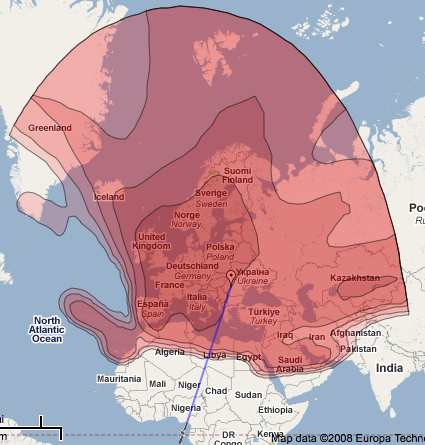
- HeyWhatsThat goes mobile: geoprogramming tour de force HeyWhatsThat is now available on GPS-enabled mobiles, including the iPhone, Blackberry and Nokia as part of the Where GPS widget collection and also for Android. Want to know what those peaks on the horizon are while you’re on your trek? HeyWhatsThat will tell you… as long as you’re within cellphone range, of course. Interesting datapoint regarding the iPhone’s popularity, courtesy of a news email from HeyWhatsThat founder Michael Kosowksy:
Computation requests [for your view] are put in a queue, and because of iPhone-related demand, for the last few days the “two minute” calculation estimate has been as high as fifteen minutes. (If it goes above fifteen minutes, we just ask you to try again later.) But please note that once you start a computation you don’t have to wait for it to finish; you can leave the screen and simply come back later via the menu entry “Show me a view I’ve requested before.”
- More of Sweden in 3D: Stockholm went 3D in the browser on Hitta.se in May (blogged here) — now it’s the turn of Göteborg, Linköping and Malmö. (Possible problems in Firefox 3, works in Safari on Mac) (Via NyTeknik)
- Nostalgia trip: Just in case you read Swedish, Dagens Nyheter has an article about how an Iranian refugee in Sweden who was forced to leave his country in 1983, can now, 25 years later, visit his ancestral village of Kalajah virtually via Google Earth. Once again a newspaper fails to do the obvious and embed a dynamic map of the place, so here you go:
Gives a new poignant meaning to “looking for one’s house”.
- “Clickable” DVDs: When it comes to aid workers working in low-bandwidth countries, instead of “clickable countries” Richard Treves suggests putting all the required data into regions-based KML sticking it on a DVD. One downside of this: Information on the DVD is static, though you can completely eschew the need for an internet connection.
- Google Earth tutorial: Also from Richard Treves: Producing Maps with Google Earth, a new web tutorial for Google Earth that he’s made for the University of Southampton’s School of Geography.
- Highlands in 3D: Paul Webster from WalkHighlands.co.uk writes:
We’ve been integrating walkhighlands.co.uk website more completely with the Earth plugin/API. You can now open the 3D Highlands above the current walk from any of our walking route descriptions. And you can open the first person view from any of our pages on the mountain summits (known as Munros in Scotland) e.g. from www.walkhighlands.co.uk/munros/sgurr-nan-gillean . At any point using the plugin you can now switch between first person mode and controls so you can walk and look around about in the virtual landscape, and an overhead view with the standard controls.
Category Archives: Uncategorized
Links: Watch ice melt, DeepPhoto, NOAA coastal charts
- Arctic Melt: Ross Swick of the US National Snow and Ice Data Center writes:
With just a little over two months until the Arctic sea ice minimum I’ve put together a new animation for Google Earth. I’ve created an animation of Arctic sea ice concentration for the last 60 days which will be updated daily. The idea is folks can watch the arctic melt as it’s happening this summer.
Very cool. Download page is here (first in the list). Ross stresses that the animation is still in beta for another week or so, and that he’s appreciate any suggestions for improvements. If the Northwest passage opens up this summer, you’ll be able to check for yourself.
- DeepPhoto: I haven’t seen this distributed widely, so be sure to watch the video below about how Microsoft has been using geospatial technologies to enhance photographs. You know how when you see FBI types enhance photos in outlandish ways on CSI or Law and Order and you go “that’s not possible?” I had that same impulse while watching this video, except that here it is very possible. If you want to know what kind of plugins you will be getting for Photoshop CS5, click play…
Video: Virtual Earth Demo at Microsoft Pro Photo Summit – LiveSide.net
- YA3DGE: Jonathan Thompson of Humanlink writes:
I spent the weekend at O’Reilly’s FooCamp in Sebastopol, CA. One of the items demo’d was a screen treated with a 3D laminate. We were controlling Google Earth with a SpaceNavigator. We all had 3D glasses on; a ddd.com driver was used to do the split. I am pretty sure Damien [Stolarz] was the individual I was speaking to and I just noticed his write-up here.
- iPhone location-aware apps: I wanted to get an iPhone just so I could write a post on location-aware apps, but unfortunately I can’t just buy one where I happen to be and drop in a sim card (how I hate phone locking!). Fortunately, Brady Forrest on O’Reilly Radar has gone and written that very post.
- NOAA coastal charts: Bill Zissimopoulos of Navimatics writes:
I have developed a set of marine maps for the US coastline derived from NOAA’s Electronic Navigation Charts, which is viewable in Google Earth. I am wondering if you have the time and interest to review them for your blog. My website is here. The online charts can be accessed here.
The service is free, and the network link works fine:
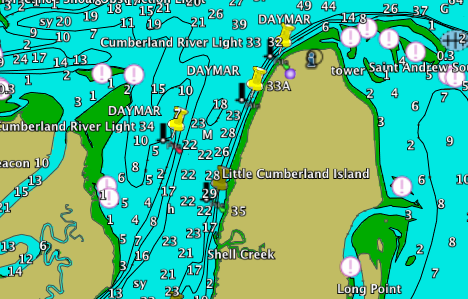
Afghanistan or Bust? Why choose
New Scientist carries a story today about how some archaeologists are using Google’s aerial imagery as a proxy for an actual excavation because… the site is in Afghanistan, and not exactly safe to visit:
Google Earth’s freely available high-resolution images are helping David Thomas and colleagues at La Trobe University in Melbourne, Australia, to forge ahead with a project called Archaeological Sites of Afghanistan in Google Earth, which catalogues details of 463 potential sites in the Registan desert. These include mounds called tepes – the remains of ancient mud cities – hand-dug underground water channels and villages.
Alas, the article doesn’t show us any of the actual locations covered, but it does point to an interesting conference poster (PDF) made by Thomas and Claudia Zipfel that highlights some of their work on the 10-12th century fortress at Bust on the Helmand river.
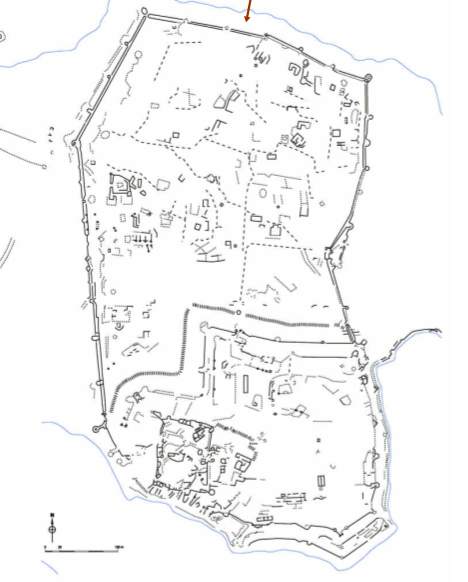
The poster contained enough information to track down the actual location:
The obvious downside to this kind of archaeology is that you are limited to the bits of Afghanistan that are visible in high resolution.
Links: Radiohead GIS, multitouch OSes, Galaxy Zoo
Ogle Earth is back, or rather back-logged after a lovely European vacation, so here is a first stab at diminishing that field of to-do flags on my screen:
- Radiohead in Google Earth! Radiohead’s new music video is made entirely from live 3D scanning techniques, with the entire 3D dataset available for further tinkering. And tinkering is what The Swordpress does, producing a totally awesome face of Thom Yorke hovering over Google Earth as a KML file:
(KML file here.) I hope more tinkering is coming — an obvious request is to use KML’s timeline support to animate Thom in Google Earth, though there is real risk of this precipitating a geek singularity.
- Multitouch Mac and PCs: When will we be able to zoom out of Google Earth simply by pinching a trackpad or multi-touch aware surface? For OS X, the framework will be in place with the next release of OS X, dubbed Snow Leopard, reports Apple Insider. Microsoft is putting the capability into Vista’s successor, Windows 7. Both OS releases are slated for 2009 — will this be the next great revolution in the mainstream UI? In a sense, it’s already here with the iPhone, which has an additional ability to use its built-in accelerometer as input, but some of the coolest stuff you can’t do yet because iPhones have battery and screen constraints.
- Mobile Google Earth? If you watch the question-and-answer session at the end of Google Geo team CTO Michael Jones’s presentation at Google I/O on May 28 2008, you’ll learn that there is a will to create a mobile version of Google Earth, but that the timing will depend on when mobile devices become good enough to provide sufficient GPU power without draining batteries.
So it is a question of when, not if. But if you had to bet on which mobile OSes will get this functionality, which would they be? My money is on Android (Google’s own) and iPhone (based on Mac OS X, for which a version already exists.) What about Nokia’s open-source Symbian, Microsoft’s Windows Mobile and RIM’s Blackberry OS? Will these be served by browser-based virtual Earths? Will Virtual Earth get a mobile version, and will it run on just Windows Mobile?
- While I was away: Google Earth got a minor update, ArcGIS Explorer got a substantial update (version 480, gaining GeoRSS support), and Google Earth’s dataset got an update (especially in Australia).
- Clickable countries: Over at Aid Worker Daily, Jonathan Thompson makes the case for “clickable countries”for Google Earth, the ability to restrict your mapping dataset to just your immediate environment, to help cope with restricted or high-cost bandwidth in developing countries, especially during disasters. An interesting idea. I’m just afraid that if it gets implemented, countries with governments that are averse to the open society will take Google to court with a view to having their country “unclicked”.
- Google Sky hearts Galaxy Zoo: Galaxy Zoo (blogged here) is an astronomical mechanical turk for sorting galaxies. It has already paid off in the form of the discovery of a
veryunique and strange object (“voorwerp”) that defies all classification, as reported in ScienceNews last month (part 1 and part 2). Now Google has given the project a $50,000 grant to incorporate Galaxy Zoo into Google Sky and add Google Sky features to Galaxy Zoo. Galaxy Zoo 2 is also under development.
In case you were wondering how my (forced) cloud-based productivity test went: I’ve been made all-too painfully aware over the past several weeks why I need a MacBook Pro and not just any old computer with a browser in an internet café. Moore’s law rocks, and may it continue to hold for a long time coming.
Three ways to make your Mac more location-savvy
Several new system-level tools have come out during the past month that enhance the Mac’s savviness in dealing with GIS- and georeferenced files.
GISLook & GISMeta: If you use Mac OS X 10.5 then you’re probably hooked on Cover Flow and especially Quick Look, two very fast ways of previewing the contents of files. Not all file formats are supported natively, however. GISLook & GISMeta is a free (donationware) utility that adds support for Shapefiles, ArcInfo files and a whole range of raster grid filetypes, including USGS DEM files. Install it, and suddenly Shapefiles will look like this on the Mac, with no further effort on your part:
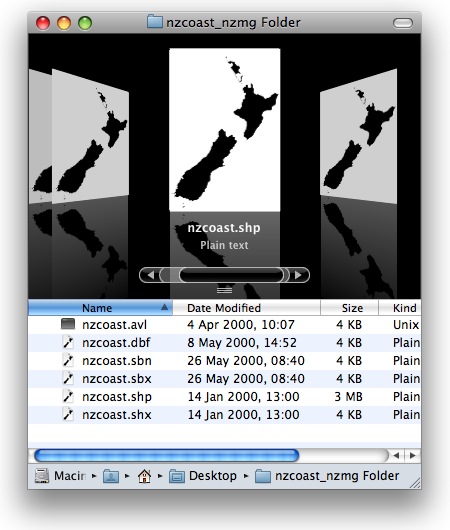
Quick Look works similarly. Installing this is a no-brainer.
GPS-Info CMM 1.1: This contextual-menu tool lets you do all sorts of things with images that have location coordinates embedded in their EXIF metadata. Version 1.0 was reviewed back in May, but now version 1.1 carries a set a new features. Developer Norbert M. Doerner lists them:
- The IPTC fields city, state, and country are being displayed, if they are contained in the photo
- The Reveal in Google Earth command now “flies” Google Earth to the GPS coordinate, and also uses the tilt, azimuth, and distance embedded in the photo for the display
- The GPS coordinate can now also be exported into a KML file
- Added SmugMug and WikiMapia to the list
- Google Maps now sets a marker with the name of the photo on the exact GPS location
Supporting tilt and azimuth settings is definitely beyond the call of duty.
GPS2Aperture: I’ve been waiting for a tool that lets me set or edit the location coordinates of the EXIF metadata of master image files in Apple’s Aperture library. Until now, the conventional wisdom has been that it’s not possible, as Aperture’s API doesn’t allow altering master images by outside applications. GPS2Aperture takes a different tack, making judicious use of OS X’s built-in scripting tools, and suddenly you can edit EXIF data, setting the location to your view in Google Earth. GPS2Aperture is free, beta, and looks like this:
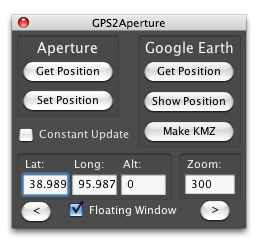
A paid premium version is underway which will let you automatically tag photos from GPS log files — much like HoudahGeo and GPS Photo Linker, but with the added bonus that you can do it within Aperture. (Note, GPS2Aperture is not an Aperture plugin but a separate small application.)
Status report
This past week, While I’ve been enjoying the splendid weather and watching football in Berlin, my MacBook Pro has been having its second brain transplant in less than a month (thank goodness for the extended AppleCare warranty plan). Now I’ve just found that it won’t be fixed in time before I set off on two weeks of travelling to assorted weddings and baptisms across Europe, which I’ve sort of wrapped into a vacation.
The upshot: Some severely limited blogging on Ogle Earth, until around mid July.
The silver lining: I’m pulling out all the stops to move almost all my daily productivity rituals onto the cloud, so that a computer failure no longer cramps my style. My move to browser-based Gmail was painless. And now that Google Gears is around for Mac, I see no more reason to use Microsoft Excel and Word. But my switch to Google Reader, which I’ve been exploring today, will go a bit slower: I don’t want to downgrade my tools just because I’m moving to the cloud. But I’m almost there (with the big exception of photo editing).
A word of caution: I’ll be testing living off the cloud these coming weeks (by necessity), and depending on how it goes, I might find myself posting more often than I promised.
Links: Stereoscopic Google Earth, Zimbabwe violence maps
- Stereoscopic Google Earth in your browser! I again have no access to a Windows system, so I can’t test this, but I suspect that José Antonio Meira da Rocha’s implementation of a stereoscopic Google Earth in the browser by placing two instances of the Earth side by side but moving the point of view a little should be fantastic! José writes that he hacked the China Syndrome example om the GE 3D web plugin API site to get the result. Remember, the 3D GE plugin is not yet functional in Firefox 3, so try it on a Windows machine with Firefox 2 or Explorer. (Via Ogle Earth comments)
- Mapping Zimbabwe’s election violence: On June 27, Zimbabwe’s opposition leader Morgan Tsvangirai will face the disastrous incumbent dictator Robert Mugabe in a run-off election that will no doubt be heavily rigged. Tsvangirai’s attempts to campaign across the country this month are being hindered at every opportunity, as his supporters are threatened or attacked… but one thing that can be done is to document these cases, and linking them to the places where they happened. Much of Zimbabwe is visible in high resolution on Google Earth, so Charles Worringham’s constantly updated KML layer of Tsvangirai’s campaign is an especially useful way into the details of how this election is progressing. Sokwanele’s “Mapping Terror in Zimbabwe: Political Violence & Elections 2008“, meanwhile, is a comprehensive Google Map of political attacks this year. Each placemark has a story attached. (Via This is Zimbabwe)
- iPhone as unmanned drone brain: That was fast: iPhone Controls Robot Plane Squad. The video shows somebody inputting coordinates of a target a flying drone goes to photograph, eventhough the GPS iPhone won’t be out for another few weeks. Might they have used an external GPS? Video is worth watching. (Hat tip: Ed Corkery)
- Poolcrashing: UK newspapers are all in a tizzy about how teenagers are using Facebook to organize to gatecrashing pool parties:
The craze involves using the Google Earth programme, which provides high-quality aerial photos of Britain and other countries.
If I were a teenager scoping for a pool to gatecrash, I’d use Microsoft’s bird’s eye view imagery — you can take a gander from all four sides, and likely also check the depth of the pool and the height of the fences — but youth these days obviously is not at resourceful as we used to be:-) (Spatial Law blog wants to know, But Is The Water Cold? Good point! Where’s our infra-red satellite view, so we can hunt the heated ones?)
- Geo-marketing mania: Mike Pegg over at Google Maps Mania ends his tenure at the blog he started… to take a position at Google’s geo-marketing team. Congrats, Mike.
- Mystery holes: In the Utah desert, some DIY geographers go investigate some strange circles they’ve spied on Google Earth.
- Y! Geo? Y! Geo is “The Yahoo! Geo Technologies Blog … the place for Place”, though so far it’s only had one entry, and it’s from June 5. (Via the James Fee GIS blog)
- Microsoft OS 7 touch UI: CrunchGear has some closeups of demos of how Microsoft’s upcoming surface technology can be used to, among other things, browse and edit photos geographically.
- Silverlight Map Viewer: It doesn’t do anything that the Google Maps API or Microsoft’s own Virtual Earth API can’t do (yet), but IDV Solutions have released a mapping demo that uses Silverlight to access and view Virtual Earth tiles. If this is going to compete with Adobe Air and the EarthBrowser that was built with it, then there is still some work cut out for them, however:-) (Via Virtual Earth, An Evangelist’s Blog, which BTW has an interesting comment stream about licensing and Microsoft’s own integration of VE with Silverlight.